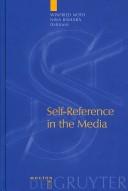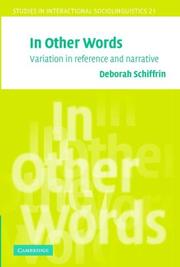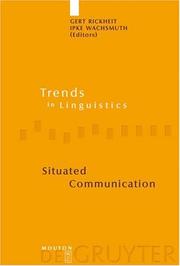| Listing 1 - 5 of 5 |
Sort by
|
Book
ISBN: 9027250502 1556193319 9781556193316 9789027250506 9789027282699 9027282692 9786613222060 6613222062 128322206X Year: 1996 Volume: n.s., 38 Publisher: Amsterdam ; Philadelphia : J. Benjamins,
Abstract | Keywords | Export | Availability | Bookmark
 Loading...
Loading...Choose an application
- Reference Manager
- EndNote
- RefWorks (Direct export to RefWorks)
The papers in this volume are concerned with the question of how a speaker's intended referent is interpreted by the addressee. Topics include the interpretation of coreferential vs. disjoint reference, the role of intonation, syntactic form and animacy in reference understanding, and the way in which general principles of utterance interpretation constrain possible interpretations of referring expressions. The collection arises from a workshop on reference and referent accessibility which was held at the 4th International Pragmatics Conference in Kobe, Japan, July 25-30, 1993.
Linguistics --- Pragmatics --- Reference (Linguistics) --- Référence (Linguistique) --- Congresses --- Congrès --- Language arts --- Signification (Linguistics) --- Onomasiology --- Semantics --- Reference (linguistique)

ISBN: 1282194577 9786612194573 3110198835 9783110198836 3110194643 9783110194647 9783110194647 9781282194571 Year: 2007 Publisher: Berlin ; New York : Mouton de Gruyter,
Abstract | Keywords | Export | Availability | Bookmark
 Loading...
Loading...Choose an application
- Reference Manager
- EndNote
- RefWorks (Direct export to RefWorks)
This book investigates how the media have become self-referential or self-reflexive instead of mediating between the real or fictional worlds about which their messages pretend to be and between the audience that they wish to inform, counsel, or entertain. The concept of self-reference is viewed very broadly. Self-reflexivity, metatexts, metapictures, metamusic, metacommunication, as well as intertextual, and intermedial references are all conceived of as forms of self-reference, although to different degrees and levels. The contributions focus on the semiotic foundations of reference and self-reference, discuss the transdisciplinary context of self-reference in postmodern culture, and examine original studies from the worlds of print advertising, photography, film, television, computer games, media art, web art, and music. A wide range of different media products and topics are discussed including self-promotion on TV, the TV show Big Brother, the TV format "historytainment," media nostalgia, the documentation of documentation in documentary films, Marilyn Monroe in photographs, humor and paradox in animated films, metacommunication in computer games, metapictures, metafiction, metamusic, body art, and net art.
Mass media --- Reference (Linguistics) --- Metalanguage. --- Second-order language --- Linguistic analysis (Linguistics) --- Signification (Linguistics) --- Linguistics --- Onomasiology --- Semantics --- Semiotics --- Semiotics. --- Metalanguage --- Reference (Linguistics). --- communication. --- media. --- Référence (linguistique) --- Sémiotique et médias

ISBN: 9780521484749 9780521481595 052148474X 0521481597 9780511616273 0511146108 9780511146107 051114654X 9780511146541 0511147112 9780511147111 0511616279 1280414685 9781280414688 9786610414680 6610414688 1107141567 0511184069 0511322771 Year: 2006 Volume: 21 Publisher: Cambridge, UK ; New York : Cambridge University Press,
Abstract | Keywords | Export | Availability | Bookmark
 Loading...
Loading...Choose an application
- Reference Manager
- EndNote
- RefWorks (Direct export to RefWorks)
What we say always consists of prior words, structures and meanings that are combined in new ways and re-used in new contexts for new listeners. In this book, Deborah Schiffrin looks at two important tasks of language - presenting 'who' we are talking about (the referent) and 'what happened' to them (their actions and attributes) in a narrative - and explores how this presentation alters in relation to emergent forms and meanings. Drawing on examples from both face-to-face talk and public discourse, she analyses a variety of repairs, reformulations of referents, and retellings of narratives, ranging from word-level repairs within a single turn-at-talk, to life story narratives told years apart. Bringing together work from conversation analysis, interactional sociolinguistics, cognitive semantics, pragmatics, and variation analysis, In Other Words will be invaluable for scholars wishing to understand the many different factors that underlie the shaping and re-shaping of discourse over time, place and person.
Reference (Linguistics) --- Narration (Rhetoric) --- Sociolinguistics. --- Référence (Linguistique) --- Narration --- Sociolinguistique --- Narration (Rhetoric). --- Reference (Linguistics). --- Référence (Linguistique) --- Sociolinguistics --- Language and languages --- Language and society --- Society and language --- Sociology of language --- Language and culture --- Linguistics --- Sociology --- Integrational linguistics (Oxford school) --- Signification (Linguistics) --- Onomasiology --- Semantics --- Narrative (Rhetoric) --- Narrative writing --- Rhetoric --- Discourse analysis, Narrative --- Narratees (Rhetoric) --- Social aspects --- Sociological aspects --- Arts and Humanities --- Language & Linguistics
Book
ISBN: 9782847887983 2847887989 2847888004 2847887997 9782847887990 9782847888003 Year: 2016 Publisher: Lyon ENS Editions
Abstract | Keywords | Export | Availability | Bookmark
 Loading...
Loading...Choose an application
- Reference Manager
- EndNote
- RefWorks (Direct export to RefWorks)
"Cet ouvrage regroupe un ensemble de contributions scientifiques destinées à éclairer divers aspects des recherches menées en France durant ces quarante dernières années autour de la cohésion et de la cohérence des textes. Les auteurs réunis dans ce volume ont ainsi souhaité rendre hommage à leur collègue et ami le professeur Michel Charolles, dont les nombreux travaux constituent un apport majeur au développement de la linguistique textuelle en France. Un accent particulier y est mis sur sa vision renouvelée des marqueurs de cohésion discursive, à la suite de ses travaux sur "l'encadrement du discours" (1997). Ces marqueurs qui guident l'interprétant dans l'accès à la cohérence du discours se regrouperaient en deux grandes familles : les marqueurs de connexion d'une part, d'indexation d'autre part. Les premiers, qui réunissent les marqueurs de continuité référentielle (anaphores) et les marqueurs de relations entre les contenus propositionnels et/ou les actes de langage (connecteurs), permettent d'établir des liens de cohésion discursive avec le cotexte amont. Les seconds, projectifs, exercent leur portée vers le cotexte aval et permettent au locuteur d'indexer des segments textuels potentiellement étendus au sein d'unités sémantico-pragmatiques que Michel Charolles a proposé de nommer "cadres de discours".
Discourse analysis. --- Cohesion (Linguistics) --- Référence (linguistique) $2 rameau --- Cohérence (linguistique) $2 rameau --- Marqueurs discursifs $2 rameau --- Cohesion (Linguistics). --- French language --- Pragmatics --- Référence (linguistique) --- Cohérence (linguistique) --- Marqueurs discursifs --- Marqueurs discursifs. --- Référence (linguistique) --- Cohérence (linguistique) --- Linguistics --- cohérence --- indexation --- cohésion --- texte --- coherence --- cohesion --- connection --- text --- Discourse analysis

ISBN: 1282194100 9786612194108 311916173X 311019774X 311018897X 9783110188974 9783110197747 9781282194106 6612194103 9783119161732 Year: 2006 Volume: 166 Publisher: New York : Mouton de Gruyter,
Abstract | Keywords | Export | Availability | Bookmark
 Loading...
Loading...Choose an application
- Reference Manager
- EndNote
- RefWorks (Direct export to RefWorks)
This volume presents important results of the Collaborative Research Center (Sonderforschungsbereich) "Situated Artificial Communicators," which was funded by grants from the German Research Foundation (Deutsche Forschungsgemeinschaft) for more than twelve years. The contributions focus on different aspects of human-human and human-machine interaction in situations which closely model everyday workplace demands. The authors are linguists, psycho- und neurolinguists, psychologists and computer scientists at Bielefeld University. They jointly tackle questions of information processing in task-oriented communication. The role of key notions such as context, integration (of multimodal information), reference, coherence, and robustness is explored in great depth. Some remarkable findings and recurrent phenomena reveal that communication is, to a large extent, a matter of joint activity. The interdisciplinary approach integrates theory, description and experimentation with simulation and evaluation.
Context (Linguistics) --- Cohesion (Linguistics) --- Reference (Linguistics) --- Psycholinguistics. --- Computational linguistics. --- Psycholinguistics --- Mathematical linguistics --- Pragmatics --- Contexte --- Cohérence discursive --- Référence (Linguistique) --- Psycholinguistique --- Linguistique informatique --- Automatic language processing --- Language and languages --- Language data processing --- Linguistics --- Natural language processing (Linguistics) --- Language, Psychology of --- Psychology of language --- Speech --- Signification (Linguistics) --- Coherence (Linguistics) --- Cohesiveness (Linguistics) --- Grammar, Comparative and general --- Situation (Linguistics) --- Data processing --- Psychological aspects --- Psychology --- Context --- Applied linguistics --- Cross-language information retrieval --- Multilingual computing --- Thought and thinking --- Onomasiology --- Semantics --- Discourse analysis --- Neurolinguistics. --- psycholinguistics.
| Listing 1 - 5 of 5 |
Sort by
|

 Search
Search Feedback
Feedback About UniCat
About UniCat  Help
Help News
News